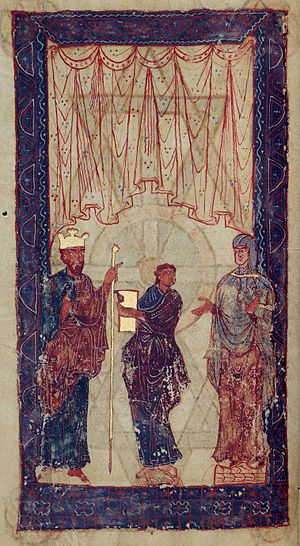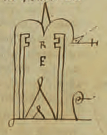Ferdinand I of León facts for kids
Quick facts for kids Ferdinand I |
|
|---|---|

Ferdinand (left) and his wife Sancha (right) receive a book of hours from its scribe.
From an illumination in a contemporary book of hours. |
|
| King of León | |
| Reign | 1037–1065 |
| Coronation | 22 June 1038 (León) |
| Predecessor | Bermudo III |
| Successor | Sancho II (Castile), Alfonso VI (León) and García II (Galicia) |
| Born | c. 1015 |
| Died | 24 December 1065 (aged 49–50) León |
| Burial | Basilica of San Isidoro |
| Consort | Sancha of León |
| Issue | |
| Dynasty | Jiménez |
| Father | Sancho III of Navarre |
| Mother | Muniadona of Castile |
| Religion | Roman Catholicism |
| Signature |  |
Ferdinand I (born around 1015 – died 24 December 1065), also known as the Great (el Magno), was a powerful ruler in medieval Spain. He started as the Count of Castile in 1029. Later, he became the King of León in 1037 after winning a battle against his brother-in-law. People say he was the first to be crowned Emperor of Spain in 1056. His children continued this tradition.
Ferdinand was a younger son of Sancho III of Navarre and Muniadona of Castile. His father's plan was for his eldest brother, García Sánchez III of Navarre, to be the main ruler. Ferdinand's rise to power changed things in Christian Spain. It moved the center of power and culture more towards the west.
Contents
Becoming Count of Castile (1029–1037)
Ferdinand was still a teenager when García Sánchez of Castile, the Count of Castile, was killed. This happened in León, where García Sánchez was going to marry Sancha of León. Sancha was the sister of Bermudo III of León, who was the King of León.
Ferdinand's father, Sancho III of Navarre, was a powerful ruler. He chose his young son Ferdinand to become the new Count of Castile. Ferdinand's mother, Muniadona, was the sister of the killed count. So, Ferdinand had a strong claim to the title.
In 1029, Ferdinand was officially given the title of count. His father, Sancho III, was recognized as the main ruler of Castile until he died. But Ferdinand was being prepared to take over.
After his father died in 1035, Ferdinand continued to rule Castile. However, he was still considered a count, not a king, and had to show loyalty to the King of León.
Becoming King of León (1037–1065)
Ferdinand married Sancha of León in 1032. She was the woman García of Castile was supposed to marry. As part of her marriage gift, some lands between the Cea and Pisuerga rivers became part of Castile.
In 1037, Ferdinand had a disagreement with King Bermudo III of León. Even though Ferdinand was supposed to be loyal to Bermudo, they fought. Ferdinand defeated and killed Bermudo III at the Battle of Tamarón.
Because his wife Sancha was Bermudo's sister, Ferdinand claimed the throne of León. On June 22, 1038, he was crowned King in León.
On September 15, 1054, Ferdinand fought his older brother García at the Battle of Atapuerca. Ferdinand won the battle. He made Navarre a less powerful state, ruled by García's young son, Sancho IV of Navarre. Ferdinand took some land from Navarre, like Bureba. Over the next ten years, he slowly gained more control over western Navarre.
Wars in al-Andalus
Ferdinand also focused on the Muslim kingdoms to the south, known as taifas. These were small, independent Muslim states.
War with Zaragoza
In 1060, Ferdinand attacked the taifa of Zaragoza. He captured several forts and reached a main Roman road. The ruler of Zaragoza, Ahmad al-Muqtadir, was busy fighting other enemies. So, he agreed to pay Ferdinand a special tax called parias. This was a payment to avoid being attacked. Ferdinand made sure this payment continued until he died.
War with Toledo
After Zaragoza, Ferdinand turned his attention to the taifa of Toledo. In 1062, he invaded the eastern part of Toledo's land. He captured Talamanca and surrounded Alcalá de Henares. The ruler of Toledo, Al-Mamun of Toledo, agreed to pay parias to Ferdinand, and Ferdinand left.
Big Raids on Badajoz and Seville
In 1063, Ferdinand used the money from these payments to launch a big raid. He attacked the taifa of Seville and the taifa of Badajoz. Both cities likely paid him money to leave them alone. This attack also helped keep Badajoz from being a threat while Ferdinand was besieging Coimbra the next year.
Taking Back Land in Portugal
Ferdinand also worked to take back land in what is now Portugal. In 1057, his army conquered Lamego. He then moved to control the Mondego River valley. He took Viseu in 1058. After a long and difficult fight, he captured Coimbra on July 25, 1064. This was after a six-month siege.
War with Valencia
In 1065, Ferdinand started his last military campaign. He invaded the taifa of Valencia. He reached the city itself and defeated its ruler, Abd al-Malik al-Muzaffar. The ruler of Toledo then took control of Valencia. The ruler of Zaragoza, scared, started paying tribute to León again. Ferdinand became sick in November and returned to his kingdom.
Emperor of Spain
Ferdinand was sometimes called "emperor" by others, even before he used the title himself. His half-brother, Ramiro I of Aragon, called him "emperor in Castile and in León" in a document from 1036.
In 1056, Ferdinand used the imperial title in one of his own documents. It said he was "emperor King Ferdinand and the empress Queen Sancha ruling the kingdom in León and in Galicia as well as in Castile." Because of this, some historians say he was crowned emperor in 1056.
Death and How His Kingdom Was Divided

Ferdinand became ill during the siege of Valencia and the Battle of Paterna. He died on December 24, 1065, in León. Before he died, he showed great religious devotion. He took off his crown and royal clothes, dressed like a monk, and lay on a bed of ashes in front of the altar at the Basilica of San Isidoro.
In his will, Ferdinand divided his kingdom among his three sons:
- His oldest son, Sancho, received Castile.
- His second son, Alfonso, received León.
- His third son, García, received the region of Galicia as a separate state.
Ferdinand also gave cities to his two daughters:
He wanted his children to respect his wishes and keep the kingdom divided. However, after Ferdinand's death, Sancho and Alfonso fought against García and defeated him. Then, Sancho and Alfonso fought each other. Sancho won and brought all of his father's lands back together in 1072. But Sancho was killed that same year, and the lands then passed to Alfonso.
Images for kids
See also
 In Spanish: Fernando I de León para niños
In Spanish: Fernando I de León para niños


